Physicist: Firstly: no. But, if you’re really set on it: maybe. The essential problems are that moving faster than light (FTL) requires impossible acceleration (not difficult but impossible in a “doesn’t make sense to talk about” kind of way), and FTL violates causality in some weird ways (for example, it allows travel backward in time).
This needs a little background, so pack a lunch.
Differently moving observers see events happen in different places. For example, if you’re in a car, everything you do seems to be happening in more or less the same place, while for someone on the side of the road all the things that you do are strung out along the car’s route.
Perspectives that are moving with respect to each other are said to be in different “frames”. So everyone in the car are in one frame, everyone waiting at a bus stop are in another frame, and everyone in an airplane overhead are in yet another frame. There’s nothing more to frames than that. So, something like “move to a different frame” just means “change speed”.
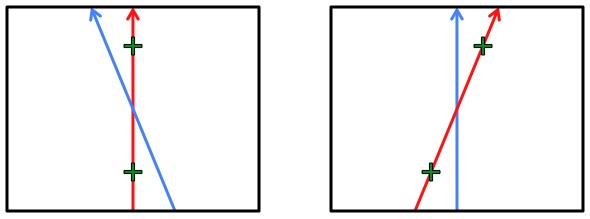
Alice (red) and Bob (blue) are moving with respect to each other. For no particularly good reason Alice sets off two firecrackers (green crosses). In Alice's frame (left) the explosions happen in the same place, one after the other. In Bob's frame (right) the explosions happen in different places. In all of the diagrams in this post, time is up and space is right/left.
Galileo (the famous one) recognized that in different frames the same events happen in different places (picture above). More than that, he realized that all of the physics that he knew of worked the same regardless of the frame (moving / not moving), and with remarkable humility he named that realization “Galilean Equivalence”.
In 1905 the ‘Stein introduced a theory about relative movement that took Galilean Equivalence (physical laws are the same in all frames) and added invariance of light speed in all frames. This is the corner-stone of relativity, and it’s called the “Einstein Equivalence Principle”. The first big result of the EEP, is that not only do different frames disagree on where events happen, but also when. It’s a bit much to go into, so if you’re interested in why, there’s an “explanation” in this post.
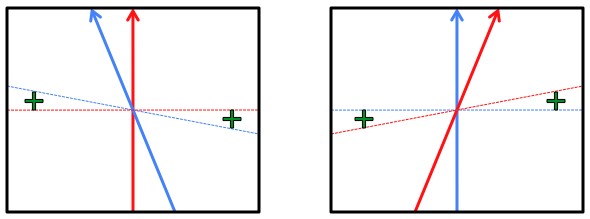
Different frames (red and blue) disagree on, among other things, what "now" is. The time that an event occurs, and even the order of events, can be changed by moving from one frame to another. The dashed lines are a single moment in time, (which are different) from each frame's perspective.
In the world according to Galileo (pre-relativity) any event could be moved relative to any other just by moving very fast. For example if two events happen in the same place, but one hour apart according to Alice, then Bob can make the second event happen 60 miles away from the first by moving at 60 miles per hour relative to Alice. Sadly, questions about “who’s right?” aren’t valid. The universe has no “preferred frame”.
In Galileo’s old-timey world view there are some restrictions to how events can be rearranged from one frame to another. Namely, the time when an event occurs never changes, and the future is always the future, and the past is always the past.
With the advent of relativity that was no longer the case, however, new restrictions popped up. A pair of events can be separated in three ways: timelike, lightlike, and spacelike.
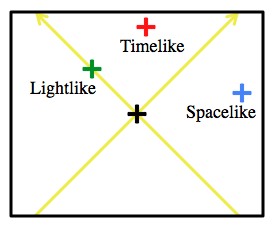
For a given event (center, black) all other events fall into one of three categories: timelike, lightlike, or spacelike separated. The yellow lines represent the path that light takes through the given event. The spacelike event can move around in its area on the right (even allowing it to occur before or after the center event), and the timelike event can move around in its area on the top.
Timelike separation means that there’s some frame in which the two events happen in the same place. That is, if you move fast enough (slower than light) you can be present at both. Timelike separated events always happen in an order: no matter what frame you’re in, everyone will agree which event happened first and which happened second. Every event you’ve ever personally experienced has been “timelike separated” from every other.
Lightlike separation means that to be present at both events you’d have to be traveling at light speed.
Spacelike separated means that there’s no way to be present at both events, even travelling at the speed of light. Things that are happening in Alpha Centauri “right now” are spacelike separated from us (right now). There is always some frame in which spacelike separated events happen at the same time, but never in the same place. Even weirder, spacelike separated events don’t have an order. Different frames will disagree on which happens first.
So, finally: here’s the issue. If you accelerate like crazy, get a huge rocket or whatever, the highest speed you can get up to is almost the speed of light. The “start” and “stop” events of your journey will always be timelike separated, regardless of how high your acceleration, or how long you accelerate for. Traveling faster than light means that your start and stop events are spacelike separated, and there is no physically real acceleration that can get you to move like that. Most people are willing to forgive that, and say: “Dude, wormholes and warp drives! S’cool!”. But those brave souls still need to contend with the second issue: causality.
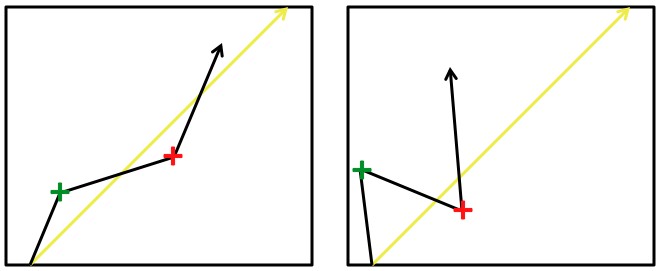
A ship with some kind of FTL drive races a beam of light. Left: The ship engages the drive (green cross), simply moves faster than light for a while, then disengages the drive (red cross). Right: The exact same situation as viewed from a different frame.
Say you’ve got the Enterprise (NCC-1701) and it works just like you’d expect: it cruises around at sub-light speeds until it engages its warp drive, which allows it to move at FTL speeds. It moves from one star system to another, then eventually disengages the drive and “drops out of warp”, no harm no foul. However! When viewed from a different frame, the same situation can be very strange.
The engage and disengage events are spacelike separated, so they don’t actually have an order. From (any one of) the proper frames, the disengage event can happen first (right half of the image above). When that’s the case you find that:
-First there’s one ship, traveling slower than light.
-Then suddenly, and without cause of any kind, two new copies of the ship appear at a place some distance away. One is traveling faster than light, and the other is traveling slower. This event corresponds with the drive being shut down.
-The FTL version travels backward until it contacts the original ship, at which point they both disappear at the moment that the original engages its drive.
Now, sure, ships coming into existence and popping out again may seem bad enough, but the big problem is that FTL travel opens the door to backward time travel (forward is fine: you’re doing it now).
By taking a couple spacelike paths that end earlier than they started you can zig-zag back in time and find yourself in the same place you started, but earlier than the time when you originally left (in the example on the right side of the picture above the route gets you back to before you left, but in a different location).
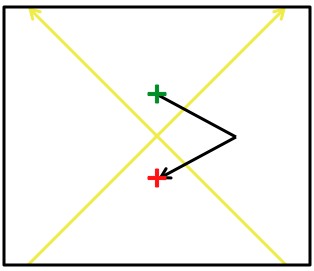
Time traveling zig-zag: If you can get into the past somewhere else once, then why not do it twice and get into your own past?
There are a lot of problems with time travel (see: “Time Cop” and “Back to the Future”). But, paradoxes and amazing one-liners aside, it seems to be very impossible. There is no indication, direct or indirect, that the future can affect the past at all (except for psychics, obviously), let alone that anything can physically move from the future to the past. So; case closed. As long as the future follows the past, nothing can travel faster than light.
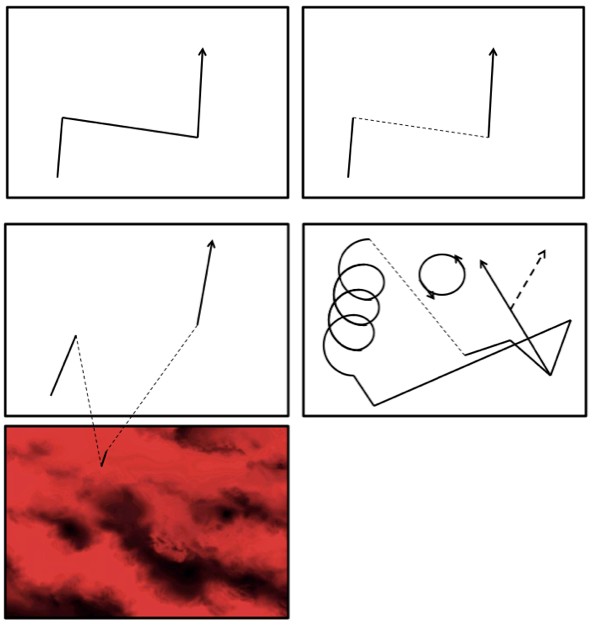
Spacetime diagrams for some sci-fi ideas about FTL (from left to right, then top to bottom): Star Trek or Star Wars, Battlestar Galactica, Babylon 5, and Dr. Who. Dashed lines are connections, not traversed distance. Click to enlarge.
But wait! Despite their romantic prospects, physicists are consummate, rarely-say-die, optimists. In that vein they’ve come up with several scenarios that (if real) would allow for FTL travel, but circumvent the whole time-travel thing.
The quickest way is to alter one of the basic assumptions of relativity; namely that all frames are equivalent. Just declare that FTL travel is possible, but only in one direction. That prevents things from zig-zagging into the past, but it also makes space travel kinda boring. Sure you can explore stuff, but you can never get home.
Alternatively, you can declare that there exists one unique frame such that no paths into the past are possible. Although other frames still get weird effects (disappearing ships, and causeless events, and whatnot), nothing can to loop back into its own past. I think this is the idea that most sci-fi shows and books are working with, but that’s meeting them more than half way.







Pingback: New habitable planet only 20 lightyears away - US Message Board - Political Discussion Forum
Pingback: Entanglement omnibus! | Ask a Mathematician / Ask a Physicist
Pingback: Q: Is the Alcubierre warp drive really possible? How close are we to actually building one and going faster than light? | Ask a Mathematician / Ask a Physicist
Pingback: Warp Capable Ship Concept - Page 2
Pingback: Q: With entangled particles, can you tell when/how the other particle is measured? | Ask a Mathematician / Ask a Physicist